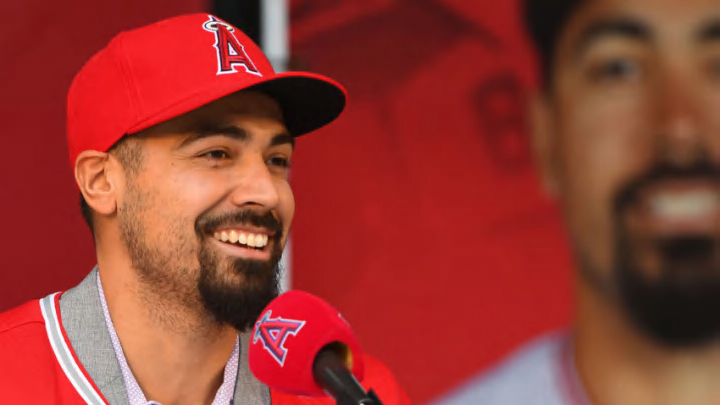The Los Angeles Angels project to commit more than 80 percent of their 2020 budget to offense. That is a far higher percentage than successful teams commit.
What is it that the Los Angeles Angels have against pitchers?
Or is it just a front-office fetish-level faith in offense?
With the signing of free agent third baseman Anthony Rendon, the Angels are once again on track to be the most heavily offensive-oriented team in baseball. Pending further developments, the Angels currently project a $175 million payroll for 2020, 82 percent of which is committed to the offense.
And that’s counting two-way star Shohei Ohtani as a pitcher. Slide the bulk of Ohtani’s 2020 contract into the offense column and that percentage climbs even higher.
More from Call to the Pen
- Philadelphia Phillies, ready for a stretch run, bomb St. Louis Cardinals
- Philadelphia Phillies: The 4 players on the franchise’s Mount Rushmore
- Boston Red Sox fans should be upset over Mookie Betts’ comment
- Analyzing the Boston Red Sox trade for Dave Henderson and Spike Owen
- 2023 MLB postseason likely to have a strange look without Yankees, Red Sox, Cardinals
Is that kind of payroll imbalance unusual? Very much so…except, recently in Anaheim. Across the majors, teams generally end up dividing their payroll about 50-50 between the mound and the field. The 2019 World Series winning Washington Nationals were one exception: with a rotation led by Max Scherzer, Stephen Strasburg and Patrick Corbin, the Nats committed nearly 60 percent of their payroll to pitching.
With the re-signing of Strasburg, that figure is likely to rise to about 66 percent in 2020.
The difference is that, as the Nationals just proved, it’s possible to win with a payroll heavily biased toward the mound. Teams that bias toward their bats aren’t nearly as successful.
In a 2004 analysis published in “The Book on The Book,” https://www.amazon.com/Book-Landmark-Inquiry-Strategies-Actually/dp/0312332645I identified several different potential systems of roster development, and analyzed the success of each. Times have changed, but the data hasn’t markedly moved.
Teams that emphasize pitching in their financial decisions win, on average, about 51 percent of their games During the period encompassed by the original study, there were 38 such teams, 14 of which (37 percent) qualified for post-season play. Not a bad formula.
Then there were the 26 teams that emphasized mid-order offense, which at the time was defined as committing more than 39 percent of team payroll to the team’s three best-paid batters. Of those 26, only two played a post-season game. The average winning percentage of the group was just .464.
Of last season’s 10 post-season teams, the greatest commitment to the heart of a team’s order was in Atlanta, which paid Josh Donaldson, Freddie Freeman and Ender Inciarte 43 percent of the team’s total payroll. The average commitment to mid-order offense of those 10 playoff teams was 28.4 percent. The Angels, by contrast, committed half of their payroll to their projected 3-4-5 hitters, the highest percentage in baseball in 2019..
In recent times, the Los Angeles Angels have been poster children for the belief in offense. Two years ago, the eight most highly paid Angels were all position players. Last season the five best-paid Angels swung a bat, and the team won 44 percent of the time.
For this upcoming season, Mike Trout, Rendon, Justin Upton, Albert Pujols and Andrelton Simmons project to reprise and extend that offensive commitment to the tune of $138 million among the five of them. That in itself is roughly 80 percent of every dollar the Angels are likely to pay out in salary.
In fact Upton, at $21 million only the fourth best paid of the Angels sluggers, projects to make more in 2020 than all but the two best paid Angels pitchers will make in combination. Recent signee Dylan Bundy and holdover Andrew Heaney are both projected to make between $4 million and $5 million next season. Subtract them and the entire remainder of the Angels staff – that’s counting Ohtani – will draw on the order of $1 million less than Upton, depending on the outcome of a couple of arbitration cases.
Counting Ohtani, the Angels have 23 pitchers on their present 40-man roster, not one of whom is under long-term commitment, and 18 of whom are pre-arbitration. The only exceptions are Bundy, a third-year arbitration eligible, as well as Heaney, reliever Hansel Robles and Cam Bedrosian, all second-year arb eligibles, and first-year eligible Keynan Middleton. With Ohtani, they are the only pitchers who might top $1 million in 2020. And there’s no guarantee of that for either Middleton or Ohtani.
Beyond that, the Los Angeles Angels project to be offense-dominant for the foreseeable future.
The mega deal Pujols signed in 2012 pays him $28 9 million this season and $30 million in 2021. The deal Trout signed last season will net him 35.5 million through 2030. Upton is owed $23 million in 2021 and $28 million in 2022. Only Simmons’ deal expires at the end of this season.
Then of course there’s the $35 million which, as of last week, they owe Rendon annually through 2026.
